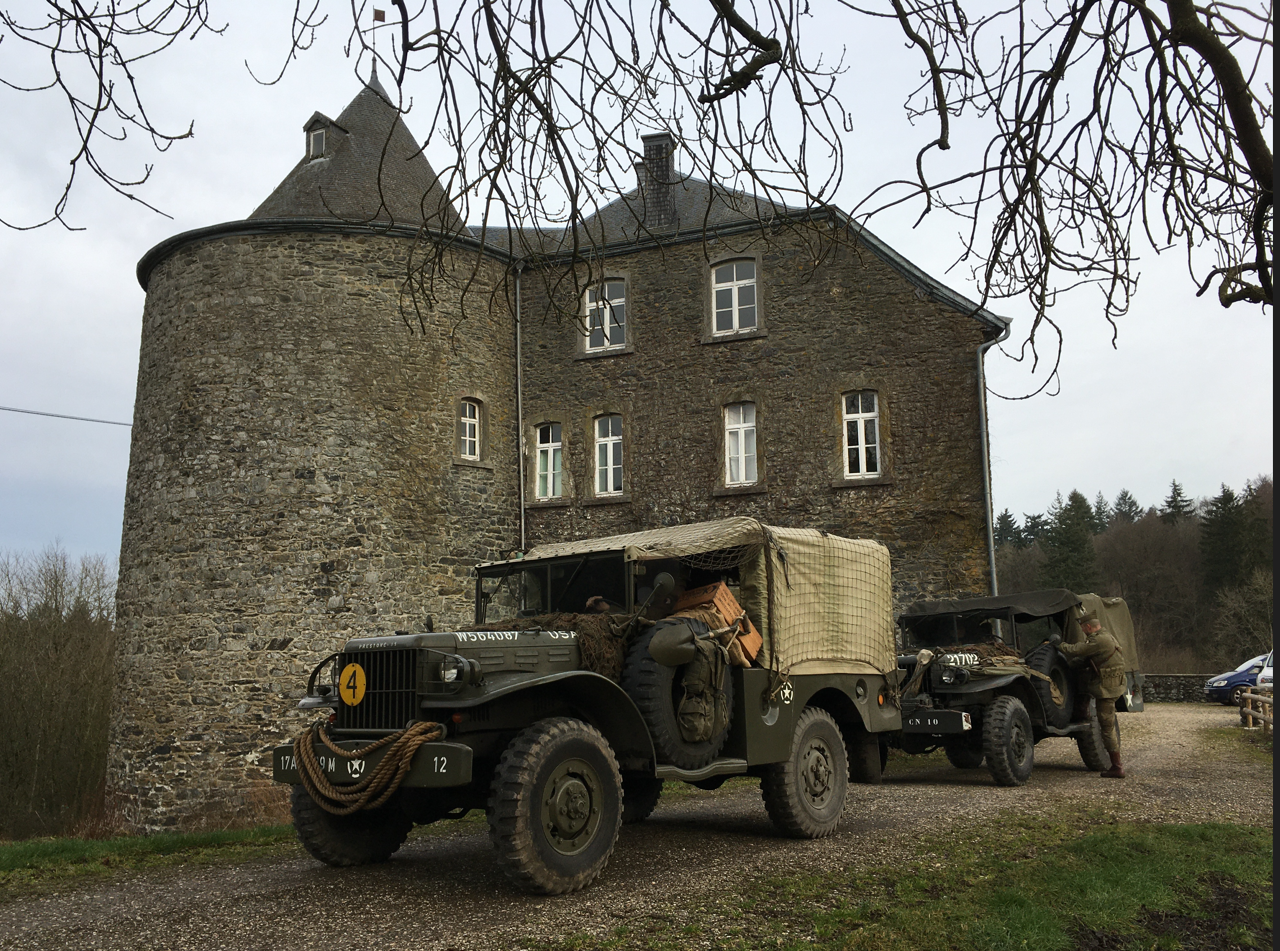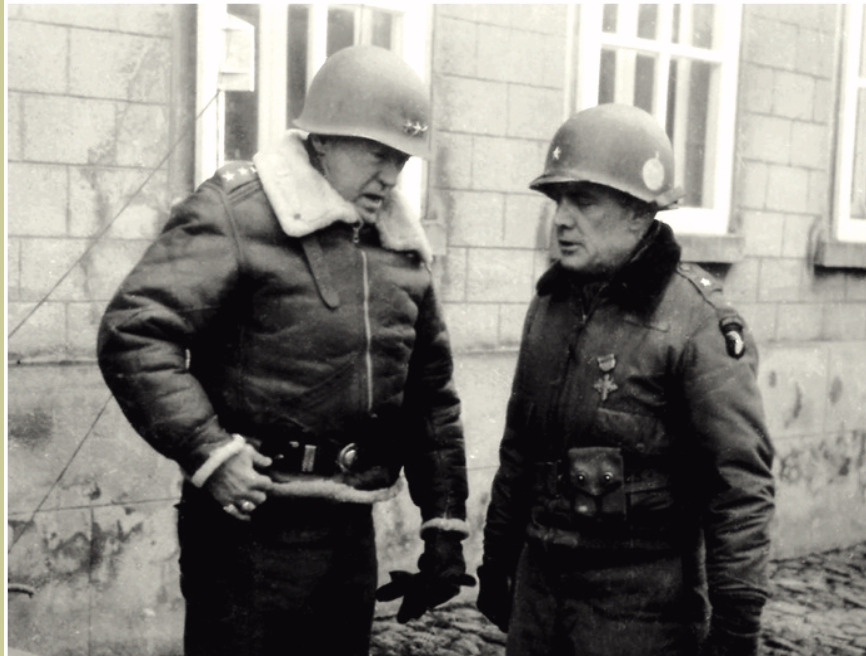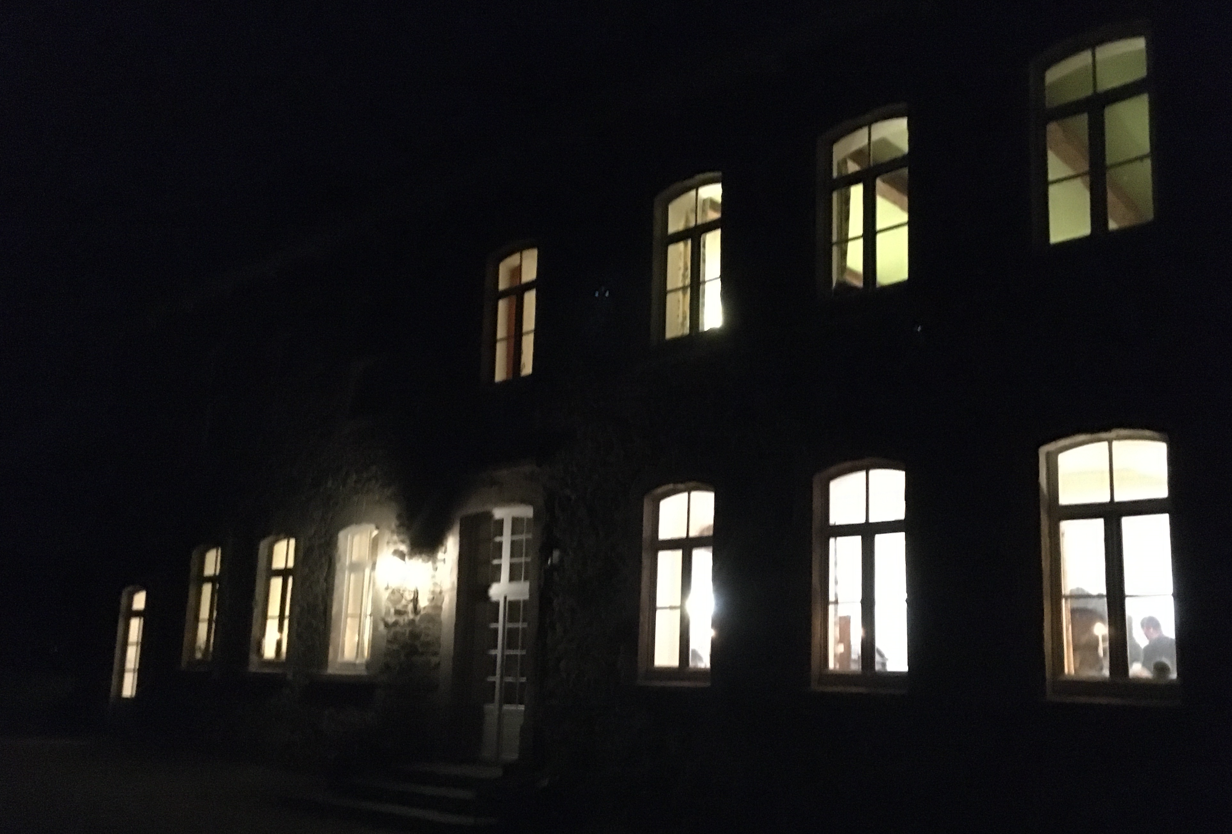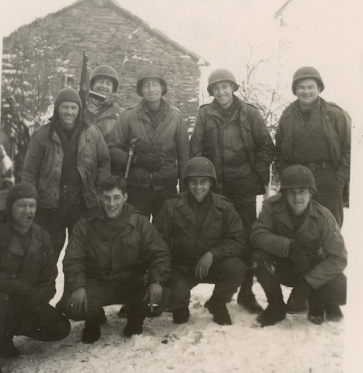Chateau Rolley... the silent witness to so much history.
The original fortress was built 1000 years ago when this south-eastern corner of Belgium belonged to the Kingdom of Luxembourg. The area is covered with pine forests, rolling hills, deep gorges and gurgling streams. Scattered across the land are the occasional manor houses or "chateau" belonging to counts, dukes and duchesses who inherited large tracks of land or purchased the properties when their fortunes grew.
Jeeps by Lionel Colla
This quiet corner of Belgium was overrun by the Germans many times before. The last time was in December 1944 when the Allies thought that the Germans had been beaten back and ready to surrender after D-Day and subsequent invasion into France. Much to their surprise Hitler planned a massive counter-invasion and sent half million men into the Ardennes forest area on the border between Germany and Belgium. Within the first two days of fighting the Germans had killed, captured or wounded nearly 10,000 US soldiers. The Allied command was caught off guard, and to put the best spin on it, they told the worried press reporters that it was just a slight "bulge" in the front lines with Germany. That's how the the "Battle Of the Bulge" got its name.
Nestled in the heart of the Ardennes forest, on a highland plateau, sits the market town of Bastogne. It was soon surrounded by the Germans infantry and their machines of war. The Chateau Rolley stood as a sentinel just north of Bastogne and soon became part of the defensive perimeter that the American forces constructed around the town. Just like in the old western movies - the Americans circled their wagons to fight off their foe. Instead of yipping and hollering Indians it was screaming German bombs and their massive tanks that were encircling them.
One of the soldiers that was stationed at the Chateau during the Christmas siege was Captain Joseph Pangerl. He wrote home in a letter home on December 30, 1944: “Just now, I am in a beautiful 17th-century castle which also serves as my home. It has been modernized but, naturally, still has the three-foot thick walls all around and you know what that means in combat, dad. In front of the castle is the former castle: this one of the 10th century. The first days here I spent quite a lot of time going around taking pictures. The setting here is much like a Hollywood one. We are on a small hill with hills all around us, covered with pine forests. There are the small lakes and rushing brooks that you always associate with such a setting and the fact that it snowed over a week ago and all the snow is still on the ground makes everything look like a Xmas postcard”.
from: https://www.warhistoryonline.com/guest-bloggers/patton-awarded-mcauliffe-101st.html (see active link below)


The photo above shows James J. Hatch, one of the 101st soldiers who fought in the battle and was later selected after the war to take part in the movie "Battleground" which came out in 1949. A number of 101st soldiers played extra roles in the movie (i.e. as background soldiers in different scenes). As part of the advertising of the movie, nineteen of these soldiers were flown back to Belgium to visit Bastogne and to attend the world premier of the movie (in what was called then the Patton Cinema in downtown Bastogne).
The movie "Battleground" is still considered one of the best movies about the battle. The screen play for the movie was written by Robert Pirosh and apparently every line in the movie was reviewed by General McAuliffe (who was onsite during the filming in California). During the war, the screenwriter Mr. Pirosh served as a Sergeant in the 35th Infantry Division that came to the relief of the 101st and the city of Bastogne. After the war Mr. Pirosh wrote many popular US movie screen plays and won many awards in Hollywood.
The picture below shows James J. Hatch giving a copy of the movie screenplay to Gaston MAUS de ROLLEY. The women next to James Hatch is Nicole LE HON MAUS de ROLLEY , the daughter in-law of Gaston MAUS and the mother of the child in the photo (Edith MAUS de ROLLEY).

Both Nicole and her father-in-law Gaston MAUS de ROLLEY were active in the Belgian Resistance during the war. They were members of the "Comete Line"- which was a Belgian secret network to rescue downed Allied pilots and crew. The Comete Line moved the airmen through a series of safe houses from Brussels, through France and into Spain where they could then fly or take a boat back to England.
Nicole (LE HON) MAUS's codename during the war was "Madame MONS". It helped that she spoke English and could communicate with the British, Australian and Canadian fliers. In August 1943 four downed allied airmen were taken in by the MAUS family in a small house on their property. The airmen stayed a few days and were then were then moved by train to Brussels and Paris and eventually to Spain where they were able to return to England.
Below is a link to one of these missions that Madame MONS was involved in. Please note that the webpage below has an option for French, English, Dutch at the top left corner:
Above: In the main living area of the Chateau
Below: James J. Hatch talks to Madame "MONS" in the Chapel that is built into one of the original towers of the chateau. The chapel was a safe place to hide during the battle thanks to the 3 foot (1 meter) thick walls of stone.
Below: General Patton visited the chateau on December 29th - 30th. After viewing with delight the burnt out German tanks on the road nearby. At the chateau he awarded medals to the officers of the 101st, and then took a short nap in the bedroom on the second floor (US "second floor" - European "first" floor above the ground floor...) The bedroom is to the left as you go up the stairs. After his nap Patton headed back out to inspect artillery positions before driving through Bastogne and its perimeter that was still under attack by the Germans.
From a letter to his parents Capt. Joseph Pangerl:
“This afternoon we had the pleasure of General Patton’s presence. He came right out of the castle and pinned a medal on our Colonel, for we were the regiment that finally stopped the last big German effort. I was waiting for him with my camera outside and as I took his picture he walked over toe me and said, “Now get a good one”.
Above: me (to the right) holding onto my dog Buddy with my two brothers and cousin when we stayed at the chateau in January 2020.
Below: Dining room
In the main dining room.
Above: The Master in the Master bedroom.
View from pond below.
At night.
Entry hall
Below is an excerpt from the book describing Christmas at the chateau during the Battle of the Bulge: The Battered Bastards of Bastogne: A Chronicle of the Defense of Bastogne
The above from:
The Battered Bastards of Bastogne: A Chronicle of the Defense of Bastogne
US ARMY Field Telephone Switchboard BD72 (courtesy of Lionel Colla)
Here are some links about the Castle :
Very good recap of the fighting around the chateau and quotes above from
Joseph Pangerl are at:































Comments
Post a Comment